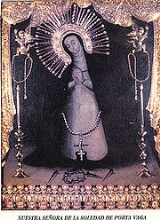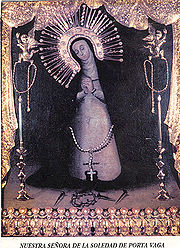
Nuestra Señora dela Soledad de Porta Vaga
Encyclopedia

Cavite City
The City of Cavite is a fourth class city in the province of Cavite, Philippines. The city occupies a hook shaped peninsula jutting out into Manila Bay. Cavite City used to be the capital of the province...
.
Description
The Blessed Virgin Mary is depicted as Our Lady of SorrowsOur Lady of Sorrows
Our Lady of Sorrows , the Sorrowful Mother or Mother of Sorrows , and Our Lady of the Seven Sorrows or Our Lady of the Seven Dolours are names by which the Blessed Virgin Mary is referred to in relation to sorrows in her life...
. Mary, garbed in black and white attire, seems to be on her knees as she contemplates the Passion of Her Son, Jesus
Jesus
Jesus of Nazareth , commonly referred to as Jesus Christ or simply as Jesus or Christ, is the central figure of Christianity...
. Before her are the crown of thorns
Crown of Thorns
In Christianity, the Crown of Thorns, one of the instruments of the Passion, was woven of thorn branches and placed on Jesus Christ before his crucifixion...
and the nails, the instrument of Christ's Crucifixion
Crucifixion
Crucifixion is an ancient method of painful execution in which the condemned person is tied or nailed to a large wooden cross and left to hang until dead...
. The icon of Our Lady is painted on a canvas framed in carved wood. The painting is presently set with gold and silver accouterments and precious gems, which are ex votos from her devotees. An inscription found at the back of the painting says: "A doze de Abril 1692 años Juan Oliba puso esta Stma. Ymagen Haqui" ("This most holy image was placed here by Juan Oliba on April 12, 1692").". The most venerated icon of La Virgen de la Soledad de Porta Vaga is an invaluable treasure inherited by the Caviteños from their ancestors, and is the oldest extant dated Marian painting in the Philippines.
History
A legend narrates that many years ago, a small detachment of Spanish Guardia Civil was stationed at a sentry post called garita located at the end of the IsthmusIsthmus
An isthmus is a narrow strip of land connecting two larger land areas usually with waterforms on either side.Canals are often built through isthmuses where they may be particularly advantageous to create a shortcut for marine transportation...
of Rosario
Rosario (disambiguation)
Rosario, Santa Fe is the largest city of the Santa Fe province in Argentina.Rosario may also refer to:* Rosario, Sinaloa, Mexico* Rosario, Sonora, Mexico* Rosario, Agusan del Sur, Philippines* Rosario, Batangas, Philippines...
. One stormy night, while a Spanish sentinel was at his post, he perceived a halo of a bright shifting light. A dazzling apparition rose form the currents of Cañacao Bay startling the sentry with suspicion that it could be pirates who were out to ransack the port because that time, Cavite was at the peak of economic prosperity because of the galleon trade.
Frightened, the sentinel shouted "¡Alto! ¡Alto!" ("Halt! Halt!"). However, instead of stopping, the light proceeded toward him. Hence, in a loud voice he asked, "¿Quién vive?" ("Who is there?"). He then heard a sweet and melodious voice saying:
"Soldadito, ¿por qué el alto me das en noche tan fría? Dame paso. ¿No conoces a Maria?"
("Little Soldier, why halt me on a night so cold? Let me pass. Dost thou not recognise Mary?")
The sentinel, struck in awe and confusion, humbly and repentantly replied,
"Perdóname, Virgen Maria, Reina de mi devoción; pues solo soy un soldado que cumplo mi obligación!"
("Forgive me, Virgin Mary, Queen of my devotion; for I am a soldier who complies with my duty!")
The following morning, fisherman and workers at the Cavite Royal Arsenal usually passed through the Porta Vaga (Vaga Gate) found along the beach of Cañacáo Bay a framed image of the Virgin. It was close to the spot where she appeared the previous night. They brought the image to the parish priest who temporarily installed it in the parish church. Later, a small chapel was built near the Porta Vagas walls, and for three centuries it was the shrine of the Virgen de la Soledad. The icon was used to bless the galleon plying between Cavite and Acapulco (Mexico) during formal sending off ceremonies, earning her the title "Patroness of the Galleon
In 1929, a new parish priest, Fr. Pedro Lerena y Lerena of Logrono, Spain, was assigned to the Puerto. At the same time, he was appointed Rector of the Ermita. His great dedication to the cause of the Virgen de la Soledad saw the beautification and the improvement of the Ermita through the years. During the Second World War, Fr. Lerena was able to retrieve the precious image of the Virgin from a junkyard where it was thrown by the Japanese invaders and brought it to the Archbishop’s Palace in Intramuros, Manila and later to the vaults of the Philippine National Bank for safekeeping. It was brought back to Cavite only after the liberation in 1945, this time to her home at the San Roque church because the Ermita was destroyed by Japanese and the combined Filipino-American forces. Until his death in 1972, Fr. Lerena served as the guardian of Cavite’s priceless treasure.
Theft and return
On March 16, 1984, the icon of the Virgin was sacrilegiously stolen from its altar. After tedious months of search, it was recovered on August 15, 1984, albeit divested of all its original gold decorations and precious stones. Every effort was made by devotees to restore the image to its former glory, and on August 19, 1984, it was re-enshrined in the altar amidst much rejoicing.Miracles
Countless miracles have been attributed to the Virgen de la Soledad. Her mysterious apparition and the unexplained arrival of her image were initial revelations of her miraculous reign. During the terrible typhoon in 1830, a fire caused by lightning bolt hit the wooden altar of the Ermita and razed the chapel to the ground, but the image of the Virgin remained intact among the ashes. In 1856, another terrible typhoon flooded the houses, churches and public buildings within the Puerto but the Ermita, as well as its patio were found dry so the people took refuge in the Church. In 1857, a Spanish frigate based in Cavite was caught by a violent typhoon off the coast of Albay and was stranded for 20 days, after running aground. The crew prayed before an image of the Soledad. She appeared before them that night and the tide rose higher and the wind began to blow, thus releasing the frigate free from its rocky trap. There have been other miracles attributed to the Virgin with the passing of the years including present day accounts of healings, families reunited and family problems solved.Devotion
Our Lady of Solitude of Porta Vaga is one of the most venerated Marian images in Cavite. Her feast is celebrated every 2nd and 3rd Sunday of November in Cavite City, where She is honored as the Queen and Patroness of the entire Province of Cavite. Through the joint efforts of Msgr. Baraquiel Mojica, former parish priest of San Roque, and Bishop Felix Perez, this miraculous icon of the Virgin of Solitude was Canonically Crowned on November 17, 1978 by the Apostolic Nuncio to the Philippines, Most Rev. Bruno Torpigliani, DD under the reign of the great Pope John Paul II. She was the first Philippine Marian Image crowned during his Pontificate.Our Lady of Solitude of Porta Vaga is also associated with the Lenten rites as well as the All Saints-All Souls Day observance, where she is alluded as "Inang Magkakandila."
The Image was given a Pontificial High Mass at the Binondo Church, Binondo, Manila
Binondo, Manila
Binondo is an enclave in Manila primarily populated by ethnic Chinese living in the Philippines. Chinatown, Manila is the oldest Chinatown in the world, established in 1594. Historically, this was where the Spanish permitted converted sangleys, their indigenous Filipino wives, and their mixed-race...
followed by a concert featuring the works of the National Artist Lucio San Pedro.Devotion to Our Lady gave the Caviteños the opportunity to show their art skills.
A replica of the Ynang Nag-Iisa is widely venerated in different part of the country and can be found in San Isidro, Nueva Ecija
San Isidro, Nueva Ecija
San Isidro is a 2nd class municipality in the province of Nueva Ecija, Philippines. According to the latest Philippine census, it has a population of 44,687 people in 8,340 households....
, Camba, Tondo, Manila,and Buhi, Camarines Sur
Buhi, Camarines Sur
Buhi, a town in the province of Camarines Sur, Philippines. According to the 2007 census, it has a population of 70,756 people.According to the Guinness Book of World Records, Lake Buhi is home to the world's smallest edible fish locally known as "Sinarapan" .Notable Buhinons include Victor Wood...
.
TheCofradia de la Virgen de la Soledad de Porta Vaga presently led by Rev. Fr. Virgilio Saenz Mendoza and Jonnell Ryan I. Enriquez heads the devotees of Our Lady. It was established in August 1998 through the efforts of the late Antonio G. Nazareno and then Bishop Manuel B. Sobrevinias. Devotees include overseas Filipino
Filipino people
The Filipino people or Filipinos are an Austronesian ethnic group native to the islands of the Philippines. There are about 92 million Filipinos in the Philippines, and about 11 million living outside the Philippines ....
workers and other foreign nationals who flock the country to join the Porta Vaga Festival.
She is presently enshrined at the Parish Church of San Roque in Cavite city, Philippines. She has recently celebrated the Pearl Year of Her Canonical coronation (2008) and is preparing to celebrate the Silver Anniversary of the Return of Her original miraculous icon (2009).
Hymn
In 1892 Don Julian FelipeJulián Felipe
Julián Felipe , was the composer of the music of the Filipino national anthem, now known as Lupang Hinirang.julian felipe...
, the Philippine National Anthem composer, composed the hymn "Reina de Cavite", on the occasion of her fiesta and for the opening of the Exposición Regionál Caviteña. The lyrics were taken from the poem Himmo a la Virgén de Cavite by Fr. Tomás de Andrade, the rector of the Jesuit College of Cavite
Cavite
Cavite is a province of the Philippines located on the southern shores of Manila Bay in the CALABARZON region in Luzon, just 30 kilometers south of Manila. Cavite is surrounded by Laguna to the east, Metro Manila to the northeast, and Batangas to the south...
sometime in 1689.
Lyrics:
Reina de Cavite per siempre seras: Es prenda tu nombre de jubilo y paz: Reina de Cavite por siempre seras; Es prenda tu nombre de jubilo y paz. Madre Immaculada, prez del serafin, Luz de Filipinas, protegenos sin fin: Luz de Filipinas, protegenos sin fin. |

